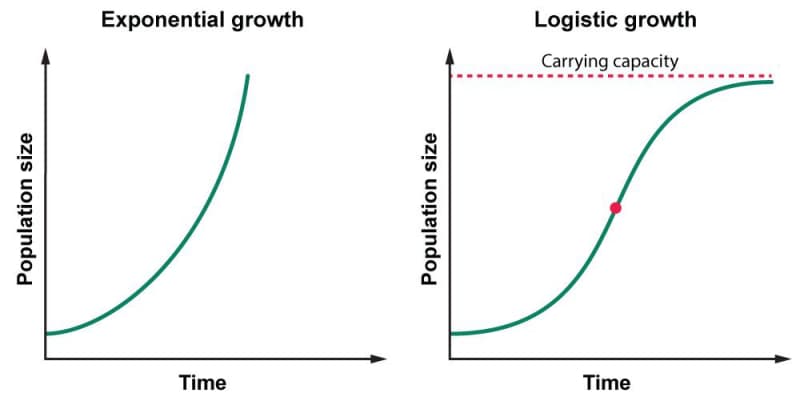Populations are groupings of individual organisms. These individuals interact with each other in intricate ways. Population ecology is the branch of ecology that looks at the dynamics between individuals, species, and their environment. It explores the processes that regulate population size, responses to environmental changes, and interactions with other species.
Population Growth
Population growth is influenced by a number of factors that influence the growth or shrinking of a population.
In general, population growth can be represented by this equation:
\(dN/dt = B – D \)
where:
dt = change in time
B = birth rate
D = death rate
N = population size
While the main components of population growth (or shrinking) are birth rate, death rate, and current population size, other influences such as immigration and emigration can also impact population size and growth rate. There are two main models for population growth – exponential and logistic. Examples of these growth curves are shown in the figure below.

Figure 8.02: Exponential and Logistic Population Growth Curves
Exponential Growth
Exponential growth occurs when there is reproduction without constraint. In this model, the population grows increasingly faster as time progresses. This leads to an accelerating growth pattern and creates a J-shaped curve. This growth pattern is usually unsustainable in nature.
Exponential growth can be represented by this equation:
\(dN/dt = rmaxN \)
where:
dt = change in time
N = population size
rmax = maximum per capita growth rate of population
Logistic Growth
Logistic growth occurs when there is limited resource availability. In these situations, a population can have so many individuals that there are not enough resources available to support the population. As limits to population growth occur, population growth usually follows a logistic model. The upper limit of individuals that an ecosystem can support is called the carrying capacity. As population size approaches this number, the growth rate slows down and eventually plateaus. Factors that limit population growth may be either density-dependent or density-independent. Density-dependent factors are things that have a bigger impact on population growth as the population density increases. These may be things like competition, predation, and disease. Density-independent factors are things that impact population growth regardless of population density. These may be things like natural disasters and climate change.
Logistic growth can be represented by this equation:
\(dN/dt = rmaxN((K-N)/K) \)
where:
dt = change in time
N = population size
rmax = maximum per capita growth rate of population
K = carrying capacity













